- Home
- Julian May
The Golden Torc Page 2
The Golden Torc Read online
Page 2
At this point, a personage named Fitharn Pegleg arrived within the hollow tree. Resembling a short, sturdy human, he proved to be a Firvulag capable of assuming a monstrous shape, one of the Little People who had originally befriended Madame Guderian in the Pliocene. As she explained her plan to liberate enslaved humanity, Madame asked Fitharn to recite an ancient lay traditional among his people. It told of the original arrival of Tanu and Firvulag on Earth in a gigantic living spaceship that had as its spouse Brede, a woman from the exotic galaxy. In making the incredible journey across millions of light-years, the Ship was fatally strained. Tanu, Firvulag, and Brede escaped from the hulk in small flyers and watched the remains of the huge organism crash upon Pliocene Europe, forming a crater "too wide to see across." To consecrate the Ship's Grave, a ritual battle was fought by two heroes—Sharn of the Firvulag and Lugonn of the Tanu—the former armed with a photonic weapon called the Sword, the latter using a similar laser-type projector called the Spear. Sham was defeated. The victor, Lugonn the Shining One, had the honor of receiving a blast from his own Spear between his eyes. Laid out in his golden glass armor, Spear at his side, Lugonn was left at the Ship's Grave to "captain it upon its final flight."
After a thousand years had passed, the remote location of the Ship's Grave had faded from the memory of Tanu and Firvulag alike. But the legend had sparked hope in Madame Guderian. The Sword of Sharn was now in Tanu hands, serving as a trophy awarded to the winner of the annual Grand Combat religious war. But the Spear of Lugonn must still be there beside the crater lake, together with the gravo-magnetically powered flying machines that had carried the exotics from their dying Ship. If the Lowlives could secure the photon weapon or a flying machine—or both—they would gain an unprecedented advantage over the metapsychic barbarians who constituted the Tanu chivalry.
Lowlives and friendly Firvulag had searched in vain for the Ship's Grave. But now Claude, knowledgeable in future geology, told them where it must be. Only one astrobleme in Europe fit the description, a crater called the Ries that lay some 300 kilometers to the east, on the northern shore of the Danube River.
Jubilation greeted this intelligence, and it was decided to mount an expedition at once. With luck, the searchers might return before the end of the month. Then Firvulag would join Lowlife humanity in an attack against Finiah—provided that the fighting took place before the start of the Grand Combat Truce beginning at dawn on October first. The expedition would consist of Fitharn, Madame Guderian, Chief Burke, a dynamic-field engineer named Martha, a former gravomag repair technician named Stefanko, and three members of Group Green. Claude would guide them to the spot. Richard (over his protests) would pilot a flyer if one could be made operational. Felice insisted she would be useful fending off wild beasts with her special talent, as well as doing chores such as hunting for food. (She had to go; around the neck of Lugonn's skeleton was a golden torc.)
Fitharn proposed that the expedition receive official sanction from the Firvulag monarch, Yeochee IV. Before leaving the tree, Madame gave secret orders to a Lowlife metalsmith, Khalid Khan, to take a group of men to a site designated by Claude, where iron ore might easily be found. They were to smelt as much of the "blood-metal" as possible and bring it back to the principal Lowlife settlement of Hidden Springs as soon as the Tanu search parties withdrew. The iron was to be kept a secret from the Firvulag, since their loyalty was strongly tinged with expedience, and no Lowlife knew how long the shaky alliance might last.
Amerie would go to Hidden Springs and reside in Madame's own house. There her arm could heal and she could minister to the outlaw humans, who had lived for years with neither a physician nor a priest. Meanwhile, messengers would go to other Lowlife settlements thinly scattered about Europe, attempting to attract volunteers for the Finiah attack—now tentatively scheduled for the last week in September.
In the Firvulag stronghold of High Vrazel, the little expedition met with a skeptical King Yeochee, who warned that the regions east of the Black Forest were full of Howlers, deformed mutant Firvulag only nominally under his authority. He presented Madame with a royal order commanding the cooperation of Sugoll, reputed to rule the Howlers in the regions around the Danube headwaters.
On the fifth day after leaving High Vrazel, in the Vosges Mountains, the expedition arrived at the Rhine—and encountered disaster in the shape of a pig the size of an ox. This creature attacked from ambush, killing Stefanko and badly wounding Chief Burke. Fitharn urged that they turn back; but the humans feared that if they delayed, the Firvulag might seek out the Ship's Grave themselves. Frail Martha, who had been forced to give birth to four children in quick succession as a Tanu slave, began to hemorrhage. Nevertheless, she was firm in demanding that they press on—and so five of them did, with the dauntless Felice carrying Martha until she was well enough to resume hiking.
Slowly, the expedition made its way up the great escarpment on the eastern Rhine shore, into the eerie zone they named the Fungus Forest, which crowned the highland where the modern Schwarzwald lies. It was not until September eighteenth that they reached the Feldberg, home of the Howler lord, Sugoll. This individual, wearing a handsome illusory body to screen hideous deformities, toyed with the humans while his horde of goblinesque subjects projected hatred and fear of the interlopers, demanding their death.
Claude brought about a reprieve when he explained the cause of the Howler mutation to Sugoll: The population had split away from their western brethren hundreds of years earlier, and had inadvertently settled in a region rich in radioactive minerals. These, combined with the exotic sensitivity to radiation, had caused the terrible birth defects. There was hope for the Howlers, Claude said, if they would move out of this area and, using their powers of shape-shifting to assume a more attractive aspect, resume mating with normal Firvulag. The Howlers might further be helped by the skills of a genetic engineer from the Galactic Milieu; but unfortunately, such a skilled scientist would surely have been enslaved by the Tanu for their own purposes.
To express his gratitude, Sugoll assisted the expedition. The subterranean source of the Danube rose only a short distance away. A single day's travel on this would bring boaters to the open river, which flowed so swiftly and smoothly that they might hope to reach the Ries Crater in only a few days more.
Once again the five people set off. Richard's navigating skill told them when they had reached the approximate longitude of the Ship's Grave. On September twenty-second, they arrived at the crater, around the rim of which stood forty-three exotic flying machines, layered in dust and lichen. A cursory inspection convinced Richard and Martha that the exotic craft were indeed gravo-magnetically powered, quite similar to the machines of the Galactic Milieu. Cleaned up, refueled with distilled water, with the exotic controls deciphered, one of those thousand-year-old birds might still fly.
Felice found Lugonn—but the golden torc was not around the ancient hero's neck. Years ago, a ramapithecine had invaded the parked flyer where Lugonn rested and had stolen the glittering bauble. Frustrated again in her quest, Felice reacted with great violence.
Richard and Martha, who had become lovers during the long trek, set about to repair a single flyer and the photon-projecting Spear, which was found next to the skeleton in armor. Time was growing perilously short; but if even one day remained before the Truce on October first, the Firvulag would join with the Lowlives in an attack upon the Rhineside city of Finiah, source of the vital element barium, without which no type of torc could be made.
Richard tested the flyer successfully on the twenty-sixth. But Martha's old affliction had returned, and she weakened from heavy loss of blood. In spite of this, she and Richard made plans to flee together immediately after he had assisted in the bombardment of Finiah. Three days later, at dusk on the twenty-ninth of September, the flyer landed at Hidden Springs with the Spear ready for use. Martha was in shock from the hemorrhaging, and Amerie could only rush her away for transfusions, praying for a miracle.
; Down on the western bank of the Rhine, a Lowlife army waited in a secret camp opposite Finiah. The city, gorgeously illuminated with twinkling lights, was still undisturbed at dawn on the thirtieth. Chief Burke was ready, together with several hundred free humans, many of them armed with iron. The Firvulag army under Sharn the Younger was also on alert—although still skeptical—poised to attack on two fronts should the promised aerial bombardment materialize.
Richard piloted the flyer to a position above the Tanu citadel. Screened by Madame Guderian's metapsychic power, the craft prepared to attack, with the photon weapon manned by the rock-cutting paleontologist. Claude fired twice and missed, but his third shot broke the Rhineside wall, allowing penetration by the Lowlives and a large unit of Firvulag. Changing targets, the old man demolished a wall on the other side of the city; Ayfa, general of the Warrior Ogresses, led in a second prong of attackers opposite the main strike. With power in the Spear running low, Claude knew that there only remained enough energy for a single great blast at the strategic barium mine in the heart of Finiah.
But now there came streaming up from the city a train of glowing knights mounted on chaliko chargers. Velteyn and his Flying Hunt had penetrated Madame's illusion and identified the enemy. The psychocreative lord sent balls of lightning soaring into the open hatch of the aircraft. Dodging, Claude fired, striking the mine squarely. Before Richard could get them away, the globes of psychic energy did their work: Claude was seriously burned, Richard lost an eye, and Madame lay on the floor of the smoldering flight deck, surrounded by toxic fumes.
Half mad with pain, Richard crash-landed the flyer at Hidden Springs. At the same time, a successful invasion of the Tanu city was being carried out by combined human and Firvulag forces. The battle of Finiah lasted twenty-four hours. At the end of that time the barium mine was destroyed, the city was in ruins, the Tanu population was slain or had fled, and the enslaved human inhabitants were faced with a choice that, for some, was oddly difficult: Live free or die.
Richard awoke in Hidden Springs and discovered Martha's body laid out in the Lowlife chapel. Remembering the promises they had made, he took her up and stumbled to the still-operational flyer. Madame and Claude were going to recover, and no doubt the old woman would press ahead with her scheme to free humanity. But not Richard. He had a plan of his own. Waving farewell to Amerie, he launched the gravo-magnetic craft into an orbit thousands of kilometers above Pliocene Earth and began to wait.
Far below, Felice was trudging through the forest toward smoking Finiah. She was too late for the war, but somehow or other she would find a golden torc in the ruined city and fulfill her promise to take the Tanu.
***
The other four members of Group Green encountered an utterly different face of the Many-Colored Land.
Six weeks earlier, the Tanu overlord, Creyn, had mounted his chaliko and departed Castle Gateway. With a minimal escort of three soldiers, he had led Elizabeth, Bryan, Aiken Drum, Stein, Sukey Davies, and Raimo Hakkinen along the track toward the Rhône River. As they traveled, the Tanu man told these privileged prisoners something of the wonderful life that awaited them. They would take ship at the riverside city of Roniah, and after a journey of five or six days arrive in the Tanu capital, Muriah. There Stein would be healed of the injuries suffered in his escape attempt. Aiken and Raimo and Sukey would learn how to use the metafunctions made newly operant by their silver torcs. Bryan would assist in a cultural analysis project that had been initiated by the Tanu King himself.
And Elizabeth ... her destiny would be the most splendid of all. Never before had the time-gate admitted a genuinely operant human metapsychic to the Many-Colored Land. (It was prohibited by Galactic statute.) Elizabeth's mind might be convalescent, but when she recovered, her farsensing and redactive abilities would far exceed those of any Tanu Great Ones. Creyn, himself a skilled redactor, was humbly aware that her probing and healing powers dwarfed his own. Elizabeth would not receive the common initiation. No, she would go to the Shipspouse who was the guide and guardian of both exotic races; she would go to Brede.
The exotic healer's promises only filled Elizabeth with fear and dismay. There was a good reason why the Galactic Milieu forbade operant metapsychics to pass through the time-gate. In the Milieu, all persons with great mental power—human and nonhuman—were bound in a benevolent Unity, incapable of any selfish action that would harm civilization. But bereft of the Unity...
Elizabeth felt as though she were the only mature adult cast away in a world of children—and malicious children at that, who would seek to use her. This must not be permitted.
Elizabeth was roused from her reverie of despair by the necessity of rescuing Sukey. This young woman, who also had redactive power, had gone snooping into the mind of unconscious Stein. Discovering his longstanding psychic hurts, Sukey tried inexpertly to drain them. Only Elizabeth's intervention prevented the deeply traumatized Viking from crushing his would-be healer into imbecility. Temporarily postponing noninvolvement, Elizabeth began to teach Sukey proper techniques so that she would not harm herself or the man she was growing to love. Before the trip south concluded, Sukey was able to bring Stein genuine relief from mental dysfunctions that had plagued him from childhood. Stein in turn reached out and pledged himself to her. Their two minds, operating on the most intimate telepathic level of his gray, and her silver, torc, took each other for husband and wife. Such a union, Creyn had warned, was forbidden to silver-torc women on pain of death; but the lovers hid their secret well. No one knew the truth but Elizabeth.
The madcap Aiken Drum's reaction to his new mind-power and the dazzling splendor of the Many-Colored Land was profoundly different. He gloried in both. In Roniah, he was the star of a rowdy debauch and the darling of insatiable Tanu women. Later, he and his new crony, Raimo, assumed the illusory forms of butterflies and took an impromptu tour of the riverside city. This ended with the partial destruction of the Roniah dock as part of a metapsychic practical joke.
Creyn programmed what he thought was a firm curb upon the trickster's metafunctions. However, as the journey lengthened, it became evident that Aiken—self-confessed Connecticut Yankee in King Arthur's court, mechanical genius, recidivist delinquent, charmer, wearer of a golden suit with a hundred pockets—was something far out of the ordinary run of latent metapsychic. The mental powers that had been chained in his skull for twenty-one years of misspent youth were of incredible potential. Elizabeth saw this clearly—and so, to a more limited extent, did Creyn.
The boat carrying the travelers plunged over a torrential slope, la Glissade Formidable, into the prehistoric Mediterranean Basin. Sailing over shallow lagoons, it approached the Tanu capital, Muriah, which lay at the tip of the Balearic Peninsula. Most of the human passengers were increasingly anxious as the voyage neared its end; but not Aiken Drum. His silver torc, instead of merely freeing his metafunctions, had acted as a trigger to a psychic avalanche. Control circuits that had easily held normal human minds in thrall burned out before Aiken's mental blaze; and his powers, unlike the gentle ones of Elizabeth, were fully oriented toward aggression. Behind the grinning face of the young man in the shining golden suit was a personality that might, in time, seek to dominate not only the exotic races of Pliocene Earth, but humanity as well.
Now begin Volume 2, which follows Aiken, Elizabeth, Stein, and Bryan on the sixth day after their passage through the time-gate into the world of Pliocene Exile.
PART I
The Mésalliance
1
THE DRAGONFLY HOVERED, a golden spark, just above the bare mast of the motionless boat.
As the first breezes broke the water with cat's-paw dimpling, the dragonfly darted off. He zoomed powerfully into the sky and hovered once again. The boat below him was now transformed into a lonely speck amid a pastel expanse of shallow lagoons and saltflats, all blurred in pearly mist.
Higher! His shape-shifted wings lofted him into the dawn. Keen compound eyes that covered most of his hea
d showed him the continental slope's dark rampart along the northern horizon: the brink of Europe punctuated by a single towering cloud that marked the cascade of the Rhône River, pouring down a vast slope of sediment into the nearly waterless Mediterranean Basin of Pliocene Earth that was called the Empty Sea.
Should he fly toward the mainland? His wings had the strength to carry him more than 100 kilometers per hour for brief sprints. He knew it would be easy for him to retrace the journey the boat had made on the previous day; or he could fly eastward to the upthrust mass of Corsica-Sardinia, where Creyn had said no Tanu lived.
He could go anywhere he liked. He was free now.
Gone were the mental restraints programmed upon him by the exotic slavemaster. This morning when he awoke, the silver torc at his throat was cold rather than warm, the neural circuitry of the psychocoercive device overloaded and rendered useless by his mind's new power. The metapsychic latencies that the torc had unlocked remained operant. And were still growing.
He reached out with his farsense, listening. He perceived the slow-cycling rhythms of the seven people asleep in the craft beneath him, and farther afield, telepathic murmurs from other boats scattered about the Great Lagoon. In the distant south—he concentrated his farsense, clumsily attempting fine focus—was a conglomerate mental shimmer. Fascinating! Could it be coming from the Tanu capital city of Muriah, the goal toward which they had been traveling these past five days?

 The Many-Coloured Land
The Many-Coloured Land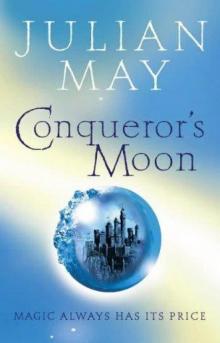 Conqueror's Moon
Conqueror's Moon The Sagittarius Whorl
The Sagittarius Whorl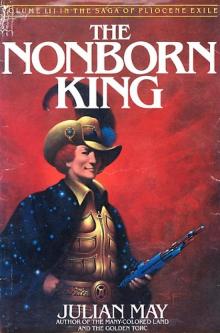 The Nonborn King
The Nonborn King Sky Trillium
Sky Trillium The Sagittarius Whorl: Book Three of the Rampart Worlds Trilogy
The Sagittarius Whorl: Book Three of the Rampart Worlds Trilogy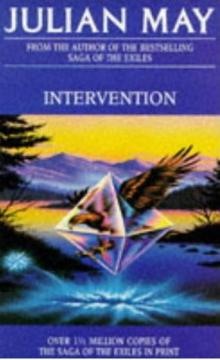 Intervention
Intervention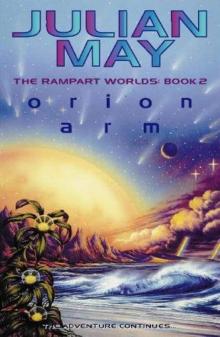 Orion Arm
Orion Arm Diamond Mask
Diamond Mask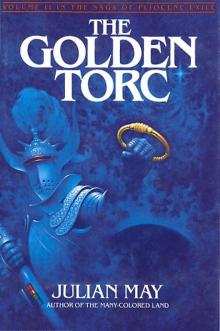 The Golden Torc
The Golden Torc The Noborn King
The Noborn King Magnificat
Magnificat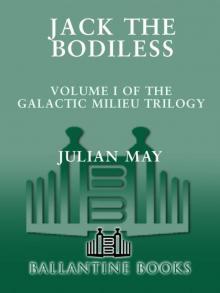 Jack the Bodiless
Jack the Bodiless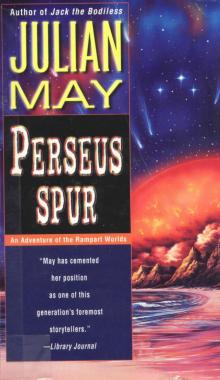 Perseus Spur
Perseus Spur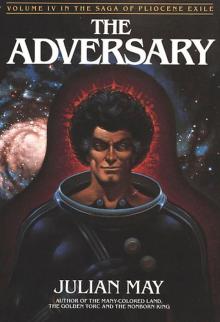 The Adversary
The Adversary Sorcerer's Moon
Sorcerer's Moon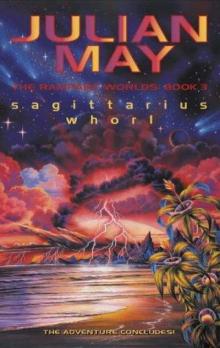 Sagittarius Whorl
Sagittarius Whorl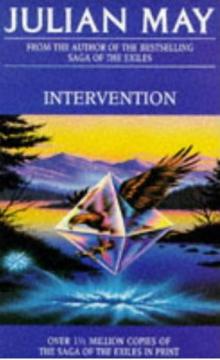 The Intervention (Omnibus)
The Intervention (Omnibus)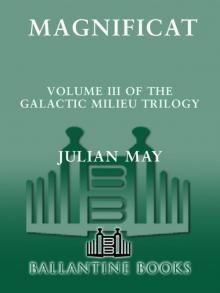 Magnificat (Galactic Milieu Trilogy)
Magnificat (Galactic Milieu Trilogy)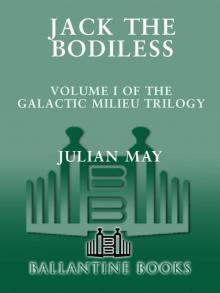 Jack the Bodiless (Galactic Milieu Trilogy)
Jack the Bodiless (Galactic Milieu Trilogy)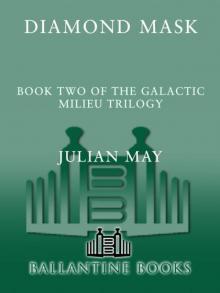 Diamond Mask (Galactic Milieu Trilogy)
Diamond Mask (Galactic Milieu Trilogy) The Many-Coloured Land sope-1
The Many-Coloured Land sope-1